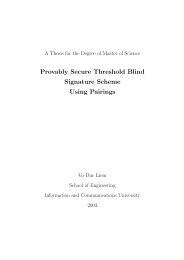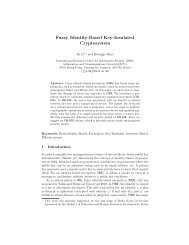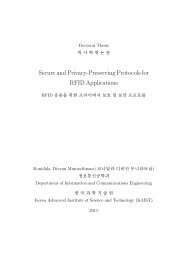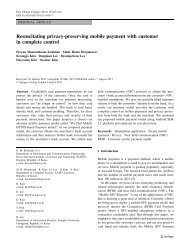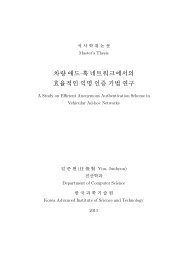Introduction to Information Security - KAIST
Introduction to Information Security - KAIST
Introduction to Information Security - KAIST
You also want an ePaper? Increase the reach of your titles
YUMPU automatically turns print PDFs into web optimized ePapers that Google loves.
<strong>Introduction</strong> <strong>to</strong> <strong>Information</strong> <strong>Security</strong><br />
(정보보호 개론)<br />
CS 448<br />
Prof. Kwangjo Kim
Week 1 : <strong>Introduction</strong> I<br />
How it begins?<br />
2
Course Overview(1/2)<br />
Objective: This course introduces the fundamental understanding on<br />
information security <strong>to</strong> build for any secure system covering the design and<br />
breaking of classical, symmetric and asymmetric cryp<strong>to</strong>system with<br />
mathematical background. We also deal with the cryp<strong>to</strong>graphic pro<strong>to</strong>cols<br />
and their applications <strong>to</strong> authentication and identification. After finishing this<br />
class, the students are expected <strong>to</strong> understand the broad spectrum on<br />
information security and cryp<strong>to</strong>graphy <strong>to</strong> advance their challenging<br />
research.<br />
Course Webpage<br />
http://caislab.kaist.ac.kr/Lecture/data/2011/spring/cs448/<br />
3
Prof. Kwangjo Kim<br />
• Contact <strong>Information</strong><br />
– Office : Room 2215@N5, 042-350-3550, 010-9414-1386<br />
– E-mail: kkj@kaist.ac.kr Home page: http://caislab.kaist.ac.kr/kkj<br />
• Career<br />
– '79 ~ '97 : Section Head of Coding Tech. #1 in ETRI<br />
– '96 ~ '97 : Adjunct Professor at Computer Science Dept. in<br />
ChungNam National Univ.<br />
– '99 ~ '00 : Visiting Professor at Univ. of Tokyo, Japan<br />
– '99 ~ ‟05 : Direc<strong>to</strong>r of IACR / Institute for IT-gifted Youth<br />
– '98 ~ ‟09 : Professor / Dean of School of Engineering in ICU<br />
– '02 : 1000 World Leaders of Scientific Influence by ABI<br />
– ‟05 ~ „06 : Visiting Scholar at MIT/UCSD<br />
– „09.1~‟09.12: President of KIISC<br />
– ‟09.3 ~ : Professor in CSD@ <strong>KAIST</strong>, Honorable President of KIISC<br />
• Academic Activities<br />
– More than 100 Program Committee Members of Cryp<strong>to</strong> and <strong>Security</strong><br />
Conferences<br />
– Edi<strong>to</strong>rs of JMC, IJIS, etc.<br />
– More than 20 invited talks <strong>to</strong> international conferences<br />
• Awards<br />
– Presidential Citation (‟09.9), Minister of NIS („09.12)<br />
4
TA: Mr. Yi Jae Park, Jiseong Gu<br />
Course Overview(2/2)<br />
Text: Handouts<br />
References:<br />
1. Wade Trappe, Lawrence C. Washing<strong>to</strong>n, “<strong>Introduction</strong> <strong>to</strong> Cryp<strong>to</strong>graphy with<br />
Coding Theory”, 2nd Ed, 2005, Prentice Hall ISBN 0-13-186239-1<br />
2. Richard A. Mollin, “An <strong>Introduction</strong> <strong>to</strong> Cryp<strong>to</strong>graphy”, Chapman & Hall/CRC,<br />
2001, ISBN 1-58488-127-5<br />
3. Mark Stamp, “<strong>Information</strong> <strong>Security</strong>: Principles and Practices”,<br />
ISBN:978-0-471-73848-0, 2005 Oct. Wiley International<br />
(한국어 “정보보안 이론과 실제”, 안태남 등 번역), and others.<br />
Grading Policy:<br />
Midterm (35%), Final (35%), Quiz (10%), HW (10%), Attendance (10%)<br />
5
Who is attending this class?<br />
• Can you survive this course?<br />
• Why did you choose this course?<br />
• What background do I need?<br />
– Programming language<br />
– Mathematics<br />
• What do you want <strong>to</strong> be after this<br />
course?<br />
• Any other question?<br />
6
Week Topic Remark<br />
1 <strong>Introduction</strong> I 2/8, 2/10<br />
2 <strong>Introduction</strong> II, Basic Terms 2/15, 2/17<br />
3 Classical Ciphers 2/22, 2/24, Quiz#1<br />
4 Block Cipher, DES 3/1(off) , 3/3<br />
5 AES 3/8, 3/10<br />
6 Mode of Operation 3/15, 3/17<br />
7<br />
Schedule (1/2)<br />
Cryptanalysis of Block Cipher, Summary<br />
I<br />
3/22, 3/25<br />
Programming HW #1<br />
8 Midterm 3/29, 3/31(off)<br />
7
Week Topic Remark<br />
9<br />
Public Key Cryp<strong>to</strong>system<br />
Number Theory<br />
4/5, 4/7<br />
10 Digital Signature 4/12, 4/14, Quiz#2<br />
11 Hash Functions 4/19, 4/21<br />
12 Cryp<strong>to</strong>graphic Pro<strong>to</strong>col 4/26, 4/28<br />
13 Secret Sharing Pro<strong>to</strong>col 5/3, 5/5 (off)<br />
14 Identification Pro<strong>to</strong>col 5/10(off), 5/12<br />
15 Special Talk, Summary II<br />
Schedule (2/2)<br />
5/17, 5/19<br />
Programming HW #2<br />
16 Final Exam 5/24, 5/26(off)<br />
8
Users<br />
National security,<br />
calculation use<br />
Trends of IT <strong>Security</strong><br />
Exclusive systems Big, host types C/S types PC, Internet Mobile & Ubiqui<strong>to</strong>us<br />
Role of information systems<br />
Direction of IT security<br />
Protection of military data.<br />
1950<br />
Efficient work style,<br />
competitiveness<br />
Reliability of<br />
systems<br />
PC<br />
Availability for<br />
critical infrastructure<br />
Internet<br />
Mobile/<br />
Ubiqui<strong>to</strong>us<br />
E-commerce<br />
Economic infrastructure<br />
Network security<br />
for e-commerce<br />
Availability for IT<br />
systems in corporations<br />
2000<br />
Lifelines for society,<br />
economy, and daily life<br />
<strong>Security</strong> for<br />
e-government<br />
Safe/reliable<br />
society<br />
Personal use<br />
SNS, facebook<br />
Small/medium<br />
enterprises<br />
Large enterprises<br />
Banking, transportation,<br />
energy sec<strong>to</strong>rs<br />
Government<br />
9
What is <strong>Information</strong> <strong>Security</strong> (1/2)?<br />
Data<br />
recording of “something” measured<br />
Raw material, just measured<br />
<strong>Information</strong><br />
<strong>Information</strong> is the result of processing, manipulating<br />
and organizing data in a way that adds <strong>to</strong> the<br />
knowledge of the receiver.<br />
Processed, s<strong>to</strong>red or transmitted data<br />
Knowledge<br />
Knowledge is normally processed by means of<br />
structuring, grouping, filtering, organizing or pattern<br />
recognition.<br />
Highly structured information<br />
10
What is <strong>Information</strong> <strong>Security</strong> (2/2)?<br />
<strong>Information</strong> <strong>Security</strong> (정보보안, 정보보호)<br />
<strong>Information</strong> security is the process of protecting information<br />
from unauthorized access, use, disclosure, destruction,<br />
modification, or disruption.<br />
The protection of computer systems and information from<br />
harm, theft, and unauthorized use.<br />
Protecting the Confidentiality, Integrity and Availability (aka,<br />
CIA) of information.<br />
<strong>Information</strong> security is an essential infrastructure technology<br />
<strong>to</strong> achieve highly trustful information-based society.<br />
Highly information-based company without information<br />
security will lose its competitiveness .<br />
What kind of protection?<br />
Protecting your private important document / computer<br />
Protecting your communication networks<br />
Protecting the Internet<br />
Protection on Cloud computing, etc.<br />
11
Taxonomy<br />
12
High<br />
Intruder<br />
Knowledge<br />
Attack<br />
Sophistication<br />
Low<br />
Attack Sophistication vs.<br />
Intruder Technical Knowledge<br />
back doors<br />
disabling audits<br />
self-replicating code<br />
password guessing<br />
sniffers<br />
sweepers<br />
exploiting known vulnerabilities<br />
password cracking<br />
hijacking<br />
sessions<br />
Cross site scripting<br />
“stealth” / advanced<br />
scanning<br />
techniques<br />
packet spoofing denial of service<br />
burglaries<br />
distributed<br />
attack <strong>to</strong>ols<br />
www attacks<br />
au<strong>to</strong>mated probes/scans<br />
GUI<br />
network mgmt. diagnostics<br />
Au<strong>to</strong><br />
Coordinated<br />
Intruders<br />
1980 1985 1990 1995 2000<br />
Staged<br />
Tools
1. From a hobby <strong>to</strong><br />
a profitable<br />
industry<br />
2. From annoying <strong>to</strong><br />
destructive<br />
3. From playing <strong>to</strong><br />
stealing<br />
4. From simplicity <strong>to</strong><br />
complexity<br />
Hacker’s Motivation
• Distributed Denial of Service<br />
(DDoS) attacks<br />
• form a significant security<br />
threat making networked<br />
systems unavailable by<br />
flooding with useless traffic<br />
using large numbers of<br />
“zombies”<br />
• growing sophistication of<br />
attacks defense technologies<br />
struggling <strong>to</strong> cope<br />
• Infected PC MS report 2010<br />
– 14.6/1000 PC in Korea<br />
– 2.2 Mil. PC in USA<br />
DDoS<br />
15
Attacker<br />
6 th July ~ 7 th July<br />
IPs<br />
Blocked<br />
8 th Jul<br />
Replace<br />
download SW<br />
with Malware<br />
Online<br />
S<strong>to</strong>rage<br />
Self Destruction<br />
Code<br />
Intermediary Host<br />
Block<br />
IP<br />
Update<br />
target site<br />
Malicious<br />
code infected<br />
Zombie Army<br />
Self<br />
destruction<br />
DDoS<br />
7 th Jul ~ 10 th Jul<br />
Self<br />
destruction<br />
Target list<br />
Target list<br />
Target list<br />
Target list<br />
Botnet Size:<br />
(over 150,000)<br />
HDD Destruction<br />
10 th Jul 00:00 ~<br />
DDoS Attack<br />
TIME ZONE : GMT+9<br />
(KST)<br />
Attack target<br />
1 st Attack Phase<br />
7 th Jul 18:00<br />
26 targets<br />
2 nd Attack Phase<br />
8th Jul 18:00<br />
16 targets<br />
3 rd Attack Phase<br />
9 th Jul 18:00<br />
7 targets<br />
16
• Difficulties <strong>to</strong> respond<br />
– Small amount of attack traffic generated from zombie<br />
• Less than 50Kbps of network traffic per PC observed<br />
– Various attack methods<br />
• Small amount of UDP/ICMP flooding (about 4% of <strong>to</strong>tal attack<br />
traffic)<br />
• Small amount of HTTP request (only 1 ~ 25Kbps of traffic<br />
measured)<br />
• http get flooding varying agent information in the HTTP request<br />
header made difficult <strong>to</strong> filter at victim sites<br />
• What did you learn from this attack?<br />
17
77DDoS A&D<br />
18



